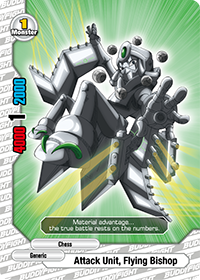 |
| You know it's important when the freaking flavor text is telling you it |
However, Buddyfight is pretty screwed up because it's leaning towards the style of Yugioh, as in, random monsters come in and screw up all ideas of consistent standard thresholds. I was totally ready to publish this article way back in April 2014, and then EB01 came out with freaking Flame Fairy Dragon, Tialvette. Like what the hell, 6000 power on a Size 1? Without any cost? Are you trying to be a douchebag, Bushiroad? Don't just suddenly decide on your own that you can create new magical standards on a whim.
Don't get me wrong, I think Bushiroad is doing a great job making Buddyfight as balanced and as fun as possible. It just makes life difficult for those of us who are trying to analyze the life out of this game.
Anyways, let's just get straight into it.
Power Thresholds
 |
| Too freaking hot to handle |
The highest power a Size 1 can have is 7000, but that's okay because Aftermath, Gagaku dies in one turn. The highest power a Size 1 can properly maintain is 6000. This used to be the sole possession of that one freaking card I mentioned earlier, Tialvette. Now, however, with Set 3, Blade Chakram Dragon gets 6000 power as well. It gets worse. With EB02, not only do we have the same clone for Dragon Knights, but also a staple Darkness Dragon World Buddy Rare with 6000 power as well. With the 7000 Legend World beast already here as well, the Size 1 magic number has undoubtedly changed from 5000 to 6000.
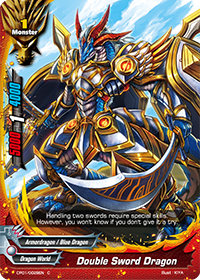 |
| The swords have been doubled! |
The highest power a Size 2 can have is 9000 power, because Dragon World broke the meta left and right. Darkness Dragon World also sports ridiculously high power monsters as well, especially of the Size 2 variety. Luckily, the issue isn't as bad because only one other Size 2 monster has an 8000 defense value (Armorknight Golem) and only one monster has 9000 defense (Armorknight Giraffa, who is relatively unplayable), which means that 8000 power is basically superficial and not as game-breaking. 7000 power, however, has now been seriously buffed. Before it was mainly dominated by Danger World cards, but now Dragon World has two new 7000 vanillas that offer much more consistency to their vanilla lineup. Don't forget that Gagaku hits 7000 as well, which means that 7000 defense is being under heavy attack. With Duel Sieger striding the power line between 7000 and 8000, both these numbers are important to control, especially with Size 2's.
All the worlds have at least a 6000 power Size 2. You obviously want to be running 4 of whatever Size 2 can hit at least this power level for you, since you don't want to be link attacking to get rid of 6K walls. Some worlds get around this by introducing link attack benefits (Adventurers, Heroes) so they don't necessarily need high-powered Size 2's. Or if you're Dragon World, just run Chakrams.
All the worlds have at least a 6000 power Size 2. You obviously want to be running 4 of whatever Size 2 can hit at least this power level for you, since you don't want to be link attacking to get rid of 6K walls. Some worlds get around this by introducing link attack benefits (Adventurers, Heroes) so they don't necessarily need high-powered Size 2's. Or if you're Dragon World, just run Chakrams.
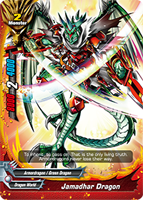 |
| Is he some kind of Persian prince? |
On a defensive side, the highest defense a Size 1 can have is 6000. Hey, that's the same level as Blade Chakram. Before, both Bronze Shield Dragon and the more important Armorknight Hellhound were extremely strong for their ability to draw link attacks as a Size 1 monster. Now, these cards can't guarantee an outright advantage over Dragon World decks anymore. It doesn't mean they're not worth running, just that they're not as much of an advantage gainer as before. Bronze Shield especially is scheduled to fall out of the limelight really fast is already totally useless. Hellhound at least hits for 5000 which is pretty good. There's also Actor Knights Lovers which, although it's not going to be killing anything anytime soon, can draw link attacks and also can hit your opponent for 1 damage (with 0 power). But honestly, with all the 6000 power monsters now, Lovers doesn't have the same exclusive spot any longer. The Level 1 stall game should be played carefully and not be used as a crutch but a tactical maneuver for stalling.
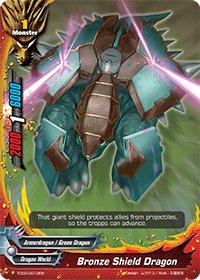 |
| Tor-torterra! |
The highest defense a Size 3 can have is 12000...oh go to hell, Duel Sieger. 9-10K is Danger World Exclusive, Dragons get a crappy 8K defender, and 7K is basically the same as Size 2s.
If you haven't guessed by now, you should probably be running spells to get rid of walls and not really bothering with too much of this walling business. Walling doesn't quite work when there's just so much removal in Buddyfight. Walling should be done exclusively as a counter tactic for a specific purpose, such as delaying the game or forcing your opponent to extend and possibly overreach.
TL;DR Magic numbers for offense are 6000, 7000, 8000, magic numbers for defense are 7000, 8000, and 9000.
Those numbers are extremely volatile and will probably change with EVERY new Booster Pack for the next year or so, so keep checking this article for updates. I had to revamp this entire section for Set 3, and please don't remind me about the vanilla 7000 power Legend World card. I only see dark clouds ahead *shudder*.
However, trends catch on slowly, and the older values aren't entirely useless. From now on, I'll try to refer to outdated values as "common numbers" and the new updated values as the "magic numbers". So for your information, current common values are 5000/6000/8000 for power and 6000/7000/9000 for defense.
Those numbers are extremely volatile and will probably change with EVERY new Booster Pack for the next year or so, so keep checking this article for updates. I had to revamp this entire section for Set 3, and please don't remind me about the vanilla 7000 power Legend World card. I only see dark clouds ahead *shudder*.
However, trends catch on slowly, and the older values aren't entirely useless. From now on, I'll try to refer to outdated values as "common numbers" and the new updated values as the "magic numbers". So for your information, current common values are 5000/6000/8000 for power and 6000/7000/9000 for defense.
What this means
 |
| The only 9000 wall... and a crappy one at that |
Of course, since the 9000 wall is going to be either a spell or a link attack, you can make up any combination of two attacks to pop that 9000 defense. 5000 + 4000, 6000 + 3000, 8000 + 1000, etc. If you're anal about Dragoenergy then add multiples of 3000 to the number based on how many Dragoenergies you expect your opponent to drop, ie 6000 + 1 x 3000.
This is why if you don't have super-stat monsters, it's better just to pack in field removal abilities and spells instead of dealing with these magic numbers. Or just field block your opponents.
Stats and Advantage
Apparently there's a need to differentiate immediate power and permanent power. Immediate power lasts for one turn (read: when it matters) and permanent power is forever.
Immediate power is really easy to calculate. Dragoenergy. For a -1, you can give any monster +3000 power and +3000 defense. So we could say that a -0.5 opportunity cost could grant you +3000 in either stat. Sounds about right. Of course Dragoenergy also grants Counterattack which is a +1 if it goes off, making Dragoenergy a +1 overall if the counter hits.
There's other examples too, like Aura Sword Dragon, Ironchain Dragon, and Jace Aldis. Also, if you look at the difference between Thunder Devastation and Dragon Flame Cascade, you'll realize that the addition of the Power clear threshold for Dragon Flame Cascade meant a -3000 in Defense clear threshold.
This isn't really huge, just add that to the card advantage equation. 1 card = 2 gauge = 2 damage = 3000 immediate power/defense.
Permament power/defense. In other words, card quality. This is going to take a while.
Thousand Rapier Dragon is the vanilla 5000/1000 dragon. For 1 gauge extra, you can run Dragon Knight, Liechtenauer for 5000/3000 and the same crit. Add an extra gauge, and you get Katzbalger Drake for 5000/5000. Of course this defense is pretty frivolous since it doesn't hit any magic numbers but it does temporary set 1 gauge = 2000 defense. This also fits for Jackknive Dragon, which is basically Extreme Sword Dragon for 1 extra gauge.
Strong Horn Dragon, Diatlus and Twinblade Dragon, Double Zase both share Penetrate with the 5000/4000 vanilla Armorknight Medusa. Diatlus gains +1000/1000 for one gauge, while Double Zase gains +2000 defense. So it seems that power and defense are interchangeable. Of course, between the two it's obvious who's better. Double Zase with good 6000 defense means a link attack/Chakram to clear on the side. And no sentient opponent would ignore a Penetrate column.
Axe Head Dragon is the vanilla Extreme Sword +2000 power for one gauge. And by now it should be clear that 1 gauge will pay for about 2000 in terms of permanent power or defense.
Updated equation: 1 card = 2 gauge = 2 damage = 6000 immediate power/defense = 4000 permament power/defense.
You can now use this equation to prove once and for all that Gigant Sword Dragon is overcosted trash.
Advantage-wise, I'm pretty sure you could find some monsters out there that are power/defense cost effective. After all, if you consider that Jamadhar Dragon is 8000/4000 but Steel Gauntlet Dragon is 4000/7000 (as opposed to 5000/7000 or 4000/8000) then you'll know that some monsters will fall through the cracks and be slightly better than average. As in a 0.25 advantage better. As in it doesn't even freaking matter if it doesn't hit magic numbers. On the topic of magic numbers, hitting a magic number should not cost anything more than 1 gauge. You want to utilize gauge for much better purposes than powering up monsters that could be easily destroyed by removal spells.
But of course there are exceptions. Armorknight Formation is one of them. For 1 gauge and 1 card, you can give +1000/1000 to every monster. Forever. You may think the -1.5 in the hole for a measly +0.5 gain is worthless, but not in Danger World. First off, they don't even really need gauge that much. And secondly, their base stats are already primed so that +1000/1000 gives them a ton of new options. Eagles become 5000/2000, hitting the magic Size 1 beater threshold as a Size 0. Hellhound becomes freaking 6000/7000, stats that rival the best of Size 2 tanks. Which, in Danger World's case, would be Armorknight Golem, now a 6000/9000 behemoth, hitting the magic Size 3 number for defense as well as the common Size 2 number for offense. This card makes Danger World a vanilla battering ram. Calvary Academy doesn't even come close.
Dragon World's vanilla game could benefit from something like this. Luckily they don't get one (or they do, but it's not that good) in the form of a spell, but they do have Death Rattle Dragon. His effect on the field gives a continuous +1000/1000 to all other monsters besides himself. Which is great because this makes Drum a 6000/6000 with Soulguard. Of course your opponent is going to want to kill Death Rattle Dragon ASAP but that's good, since it's doing its duty as a pressure column. And if you had a way to protect it (hint: you do), then you could take advantage of its global power to seriously mess with your opponent. "It's not even that threatening stats-wise, so it would be a waste to take it out with a spell." This kind of thinking will allow you to gain advantage over your opponent when they realize your vanilla game just rose leaps and bounds over theirs.
Most Magic World decks are based on using spells as this huge engine and grabbing everything they need and getting these incredibly fat hands. They usually use spells also as removal, but there's an alternate and, dare I say it, better way to play Magic World while maintaining the ridiculous draw engine. Gunrod, Stradivarius costs 2 gauge to play. You can rest it to deal 1 damage (1 gauge) and then give one of your monsters +3000 power (1 gauge). It pays for it's gauge cost the very turn it's played! And the next turn, it will have completely regained the investment made into it. It's better than Bechstein in terms of advantage, but there's a reason why it's not used as much. Magic World can hardly guarantee monsters on the field, and there's not much reason to pay that much gauge when the damage is obviously the better part of the effect.
Well, that was BT01, but BT02 gave us some ridiculous, and I mean RIDICULOUS cards for Magic World. Magic Knight of Darkness, Dunkelheit and Magic Knight of Light, Licht form a combo when called to the field together. They gain +3000/3000 each, permanently. Forever. Dunkelheit becomes 7000/6000, and Licht becomes 6000/7000. Size 1s. SIZE ONES. Just so you know, +3000/3000 is +6000 in stats overall, which should cost 3 gauge. By calling the two knights together (wash), you are gaining +12000 worth in stats. That's 6 gauge or 3 net advantage. For free. Of course, if we compare these two to other Size 1 Magic World cards we notice that they lack a 1000 to either power or defense (compared to Valefar and Bathin). So we need to realize that they start off a bit weaker (not much, though) and then calculate the net advantage relative to the vanilla scale. The result is +10000 instead of +12000, or 2.5 net advantage. Still pretty damn good, if you ask me.
Are you going to waste a spell removing a 1 critical Size 1? If you don't, you're going to have to get over 7000 defense. That is 90% guaranteed to be a link attack or a Size 3 attacker. If it's a link attack, your powered up Size 1 just converted his +1.25 advantage in stats to a +1 in material advantage - your opponent wasted an extra attack taking him down. That's the main thing. Power and defense aren't like critical or gauge, where the advantage is tangible. Power and defense are intrinsic advantage - their effects are not immediately converted to real advantage like hand or life. You have to make sure that power and defense will hit the magic numbers or do something else meaningful so they can be exchanged for the real advantage of clearing a wall or forcing an extra attack.
In addition to the Dunkelheit-Licht combination, you can Stradivarius to give Dunkelheit +3000 and have him hit for 10000, clearing every card in existence except for Tempest Enforcer. You're still going to have your Nice One!/Kosher engine in the background, and you can even use Grandfather Clock with this. If you're ever tired of running a spell-heavy Wizards deck, you might want to try using the Magic Knights combo and see how it does for your field control.
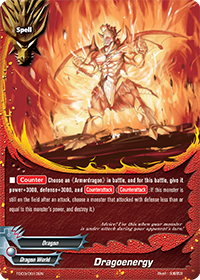 |
| Feel the burn |
There's other examples too, like Aura Sword Dragon, Ironchain Dragon, and Jace Aldis. Also, if you look at the difference between Thunder Devastation and Dragon Flame Cascade, you'll realize that the addition of the Power clear threshold for Dragon Flame Cascade meant a -3000 in Defense clear threshold.
This isn't really huge, just add that to the card advantage equation. 1 card = 2 gauge = 2 damage = 3000 immediate power/defense.
Permament power/defense. In other words, card quality. This is going to take a while.
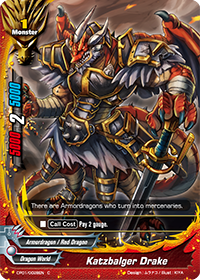 |
| What paid users get |
Strong Horn Dragon, Diatlus and Twinblade Dragon, Double Zase both share Penetrate with the 5000/4000 vanilla Armorknight Medusa. Diatlus gains +1000/1000 for one gauge, while Double Zase gains +2000 defense. So it seems that power and defense are interchangeable. Of course, between the two it's obvious who's better. Double Zase with good 6000 defense means a link attack/Chakram to clear on the side. And no sentient opponent would ignore a Penetrate column.
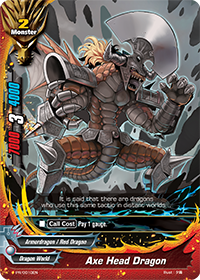 |
| My head is an axe |
Updated equation: 1 card = 2 gauge = 2 damage = 6000 immediate power/defense = 4000 permament power/defense.
You can now use this equation to prove once and for all that Gigant Sword Dragon is overcosted trash.
Advantage-wise, I'm pretty sure you could find some monsters out there that are power/defense cost effective. After all, if you consider that Jamadhar Dragon is 8000/4000 but Steel Gauntlet Dragon is 4000/7000 (as opposed to 5000/7000 or 4000/8000) then you'll know that some monsters will fall through the cracks and be slightly better than average. As in a 0.25 advantage better. As in it doesn't even freaking matter if it doesn't hit magic numbers. On the topic of magic numbers, hitting a magic number should not cost anything more than 1 gauge. You want to utilize gauge for much better purposes than powering up monsters that could be easily destroyed by removal spells.
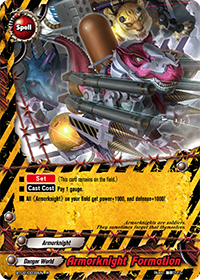 |
| Attention! Fall in! |
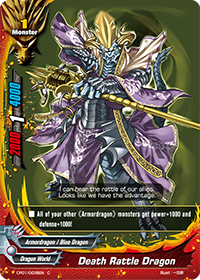 |
| What you give to zombie babies |
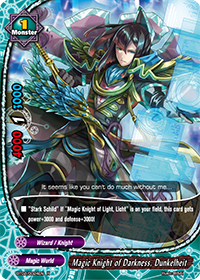 |
| Shadow Paladin |
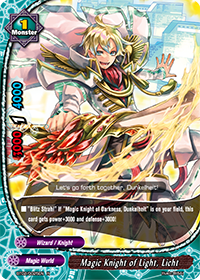 |
| Royal Paladin |
Are you going to waste a spell removing a 1 critical Size 1? If you don't, you're going to have to get over 7000 defense. That is 90% guaranteed to be a link attack or a Size 3 attacker. If it's a link attack, your powered up Size 1 just converted his +1.25 advantage in stats to a +1 in material advantage - your opponent wasted an extra attack taking him down. That's the main thing. Power and defense aren't like critical or gauge, where the advantage is tangible. Power and defense are intrinsic advantage - their effects are not immediately converted to real advantage like hand or life. You have to make sure that power and defense will hit the magic numbers or do something else meaningful so they can be exchanged for the real advantage of clearing a wall or forcing an extra attack.
In addition to the Dunkelheit-Licht combination, you can Stradivarius to give Dunkelheit +3000 and have him hit for 10000, clearing every card in existence except for Tempest Enforcer. You're still going to have your Nice One!/Kosher engine in the background, and you can even use Grandfather Clock with this. If you're ever tired of running a spell-heavy Wizards deck, you might want to try using the Magic Knights combo and see how it does for your field control.
In Conclusion
This article was pretty sprawled all over the place, trying to tie a bunch of loose ends together to finish up the advantage equation. If you're going to get anything out of the article it should be the following: magic numbers are important in Buddyfight, but there is no reason to pay more than an opportunity cost (-0.5) to get them. You want to perfect that winning image, and chances are the extra power/defense will just become frivolous. Keep things minimized and efficient, making the most out of your resources, and you'll find that gaining advantage is as easy as playing the right card.
All images were used obtained from the official Bushiroad website and used here solely for reference purposes. Future Card Buddyfight!, logos, and respective content belong to Bushiroad. Large images belong to the Buddyfight! Wikia.

Just found this on the wiki. Read everything, your math seems solid, and I like the info. This is real gold for deckbuilders. Just need to start applying this stuff to Dungeon World. Real quickly, Lifelink is worth its weight in gauge, yes?
ReplyDeleteYes, however since call cost is immediate and Lifelink is later, you're basically taking a loan now on resources you'll have in the future. There's the chance the monster never dies, which means you just gained a lot. It's very similar to how the economy works, which means that Lifelink is actually higher quality than call-cost. I'll have the math done sometime soon.
DeleteMostly I wanted the help in evaluating lifelink cards. Adventurers have low stats as a general rule, but I still like the teamwork aspect they have, and their searchability. Some of them even make it worth link attacking (Penetrate, discarding a soul) with their effects, but none of their stats hit anything this article discusses. Thoughts?
DeleteHmm...well, since Dungeon World is the first World that is actually promoting link attacking, I expect that the bonuses/gains from link attacking would be equal to 2 separate attacks of the same linked caliber. It will really depend on the specific card combo. I'll probably look at these in detail when I do Dungeon's World Analysis.
DeleteAs a danger world user, I think 2 things should be mentioned. 1, danger world decks can use a lot of gauge. Mine contains 4 hysteric spear, 4 armourknight demon, and 3 twin horn ark giraffa's, and it requires a couple lord aura meditations to stay consistant. 2, cerberus+armourknight formation=6000 attack, 6000 defense soulguarder.
ReplyDeleteI personally do not believe that is the most efficient deck build for Danger World. Advantage-wise, Danger World has far better options and strategies that are relatively gauge-inexpensive. If you're ever caught using Lord Aura Meditation or one of those cards, it usually means the deck is a bit too gauge pricey. There are exceptions, but few. And Cerberus's Soulguard is cool, but...Hellhound? Cheaper and better.
DeleteYou can wait for my Danger World analysis to get more of my thoughts.
Are you certain that Dunkelheit and Licht get the effects permanently, even if one of them dies?
ReplyDelete......
DeleteErr Blaise?
Continuous effects are permanent as long as the conditions are fulfilled.
DeleteI'm emphasizing the continuous nature of their abilities.
Please read in context. The paragraph makes perfect sense.